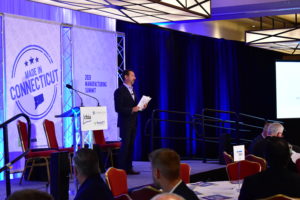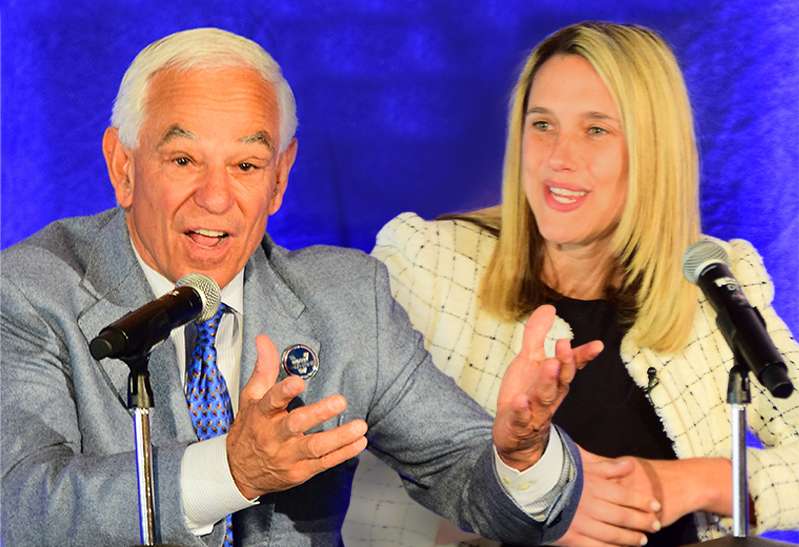
Apple CEO Tim Cook once advised that, when it comes to manufacturing, “The U.S.’s strategy should be to skate where the puck is going, not where it is.”
Determining where that particular puck is going can be a tall order, but as discussed at the CBIA”™s 2021 Manufacturing Summit, the outlook for Connecticut”™s manufacturing sector seems to be a sunny one ”“ although with some important caveats.
Released at the Summit, held Oct. 29 at the Trumbull Marriott Shelton, the 2021 Connecticut Manufacturing Report, produced by the organization and its affiliates CONNSTEP and ReadyCT, found that despite the ravages of Covid-19 ”“ during which time most manufacturers remained open ”“ the sector has a generally positive view of what 2022 might hold.
The big headline was the 88% of manufacturers in the state reported difficulty finding and retaining workers, with 41% calling the labor shortage the main obstacle to growth. Even so, 44% expect their workforce to grow in the next six months, a 24-point jump over last year.
Other notable numbers:
- 64% of manufacturers reported profits in 2020, down from 76% in 2019.
- 70% percent expect a profitable 2021, with just 10% forecasting losses.
- 53% see their businesses growing, up from 18% last year, while just 12% forecast contraction.
- 40% expect Connecticut”™s economy to grow (compared with just 10% last year), and 58% expect national growth (32%).
- 58% of employers report at least 75% of their employees are fully vaccinated.
- 87% of manufacturers applied for a federal Paycheck Protection Program loan and 14% for other U.S. Small Business Administration loans or grants.
The 2021 Manufacturing Report survey was mailed and emailed from Aug. 4 through Sept. 8 to 858 manufacturing executives throughout the state. The survey had a response rate of 25% and a margin of error of +/-3%.
 Roughly 70% percent of manufacturers who responded to the survey employ fewer than 50 employees, while 84% have less than 100 employees.
Roughly 70% percent of manufacturers who responded to the survey employ fewer than 50 employees, while 84% have less than 100 employees.
The attitudes reflected in the CBIA report are comparable to those found in the latest report by the National Association of Manufacturers (NAM). For its third-quarter survey, conducted Aug. 19 to 30 and receiving 453 responses, 87.5% said they felt positive about their company”™s outlook while 80% cited workforce challenges as their greatest roadblock, followed closely by supply chain issues (79.8%).
Speaking at a Summit panel devoted to dissecting the CBIA report, Stanley Black & Decker Senior Vice President and Stanley Industrial President Graham Robinson affirmed the sector”™s ”“ if not the nation”™s ”“ concerns over workforce, noting that almost 40% of Stanley”™s factory workers in a plant in Decorah, Iowa are over 55 years old. He advised companies to “attack” the issue of new hires.
CompassMSP CEO Ari Santiago said manufacturers need to win the “hearts and minds” of younger hires “if we want their hands to follow.” One path to success, said National Graphics Inc. Executive Vice President and CFO Michele Etzel, is to partner younger workers with more senior employees to provide a kind of mentorship that works both ways: The younger employee learns the tricks of the trade, while the older one receives a better understanding of technology and how a younger consumer thinks.
 The last point was echoed at a later panel by Burke Aerospace President Brittany Isherwood and by Bead Industries CEO Jill Mayer. “Shadowing isn”™t all you can do,” Mayer said. “Document as much as possible” from older workers, who will feel more comfortable leaving “knowing that things will go on without them.”
The last point was echoed at a later panel by Burke Aerospace President Brittany Isherwood and by Bead Industries CEO Jill Mayer. “Shadowing isn”™t all you can do,” Mayer said. “Document as much as possible” from older workers, who will feel more comfortable leaving “knowing that things will go on without them.”
Several speakers expressed a desire for the state government to step up efforts at attracting and retaining employees. In mid-October, the state”™s Manufacturing Innovation Fund (MIF) approved investments in ongoing programs that provide support to Connecticut manufacturers, including the Incumbent Worker Training Program ($1.5 million), Apprenticeship Program ($1 million) and Manufacturing Voucher Program ($2.1 million).
CBIA CEO Chris DiPentima, who said the organization is still putting together its list of legislative priorities for next year, noted that it logged 5,800 hours of lobbying during the last General Assembly session, which helped pass 23 “positive” bills and defeat 80 anti-competitive bills.
Remarking that he”™d rather “be playing offense than defense,” DiPentima said those efforts had saved companies $843 per employee.
The CBIA survey reflected the manufacturing sector”™s resilience during the pandemic. It reported 153,000 manufacturing employees and 3,796 companies as of September, compared with 155,900 and 3,965 a year ago. Total manufacturing compensation for 2020 was $15.4 billion, with the average salary $100,662, compared with 2019”™s $17.3 billion and $98,150.
The sector”™s contribution to Connecticut”™s GDP was up on a dollar basis but down by percentage: its $29.66 billion in 2020 accounted for 10% of GDP versus $26.74 billion and 11% in 2019.
State sales and use taxes paid by the sector increased from 2019”™s $223.5 million to 2020”™s $235.5 million.
Aerospace and transportation”™s status as the state”™s top manufacturing sector — $8.12 billion in output in 2020, dwarfing runner-up chemicals at $5 billion ”“ was reflected by the choice of Paul Lemmo, president of Sikorsky Aircraft in Stratford, as keynote speaker.
“We are changing the face of manufacturing,” Lemmo declared, noting that 8,000 of its roughly 13,000 employees are based in Connecticut. Over the past year, Sikorsky ”“ a division of Lockheed Martin — has spent about $450 million with over 250 suppliers in the state, he added.
The company also gave over $700,000 to various charitable organizations and close to $1 million dedicated to providing “thousands upon thousands” of PPE to hospitals and other health care providers, Lemmo said.
Lockheed has invested about $600,000 in Stratford, which Lemmo said put it on course for the $1 million it previously had agreed to.
Sikorsky is also an exception to the workforce dilemma, he said, having hired about 1,000 people last year and adding another 600 so far in 2021.






















